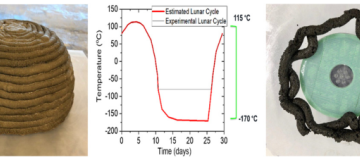
Seminario - Geopolymers: From the Earth to the Moon
Relatore: Shima Pilehvar, Department of Engineering – Østfold University College, Norway | Giovedì 11 Gennaio 2024 – ore 16,30 | Aula Arduino
11.01.2024
When developing materials for lunar construction, it is essential to minimize the weight of components that have to be brought in from the Earth. All necessary ingredients could potentially be sourced on the lunar surface, which is why the material might be an efficient construction material for infrastructure on the moon.
Since water is a highly valuable resource on the lunar surface and not readily available, using building materials with high water demand is practically impossible. Geopolymers consist of silico-aluminates in an amorphous to semi-crystalline three-dimensional structure and exhibit an excellent performance. 3D-printing of geopolymers produced from lunar regolith is an interesting option for space in situ habitats.
However, finding a chemical admixture that can be easily obtained on the moon, which can increase the workability while utilizing less water, would be highly beneficial for utilizing lunar regolith geopolymers for lunar 3D printing. Urea can break hydrogen bonds, and therefore reduces the viscosities of many aqueous mixtures. Since urea is the second most abundant component in urine (after water), it is readily available anywhere there are humans. We have therefore explored the possibility of utilizing urea as a chemical admixture for lunar geopolymers.
Severe environmental conditions like a large temperature variation between day and night, vacuum, and solar radiation are considered as the main obstacles for construction on the moon. A diurnal cycle on the moon lasts for over 29 earth days, with long periods of extreme hot and cold temperatures from 114 °C to −170 °C. High vacuum and the absence of oxygen also influence the mechanical properties of lunar constructions. In this study, the influence of the severe lunar environmental conditions such as extreme temperature variations and vacuum on the physical and mechanical properties of lunar regolith geopolymers were also investigated.





